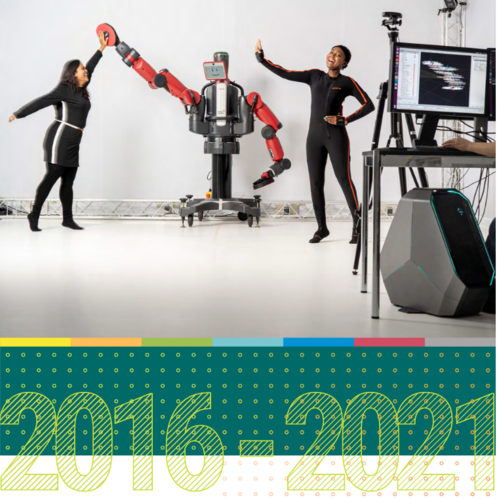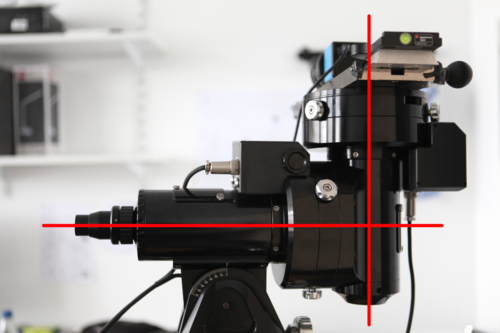2023
Jin, Z., Mihalcea, R.
Natural Language Processing for Policymaking
In Handbook of Computational Social Science for Policy, pages: 141-162, 7, (Editors: Bertoni, E. and Fontana, M. and Gabrielli, L. and Signorelli, S. and Vespe, M.), Springer International Publishing, 2023 (inbook)
2022
Biester, L., Demszky, D., Jin, Z., Sachan, M., Tetreault, J., Wilson, S., Xiao, L., Zhao, J.
Proceedings of the Second Workshop on NLP for Positive Impact (NLP4PI)
Association for Computational Linguistics, December 2022 (proceedings)
Schölkopf, B., Uhler, C., Zhang, K.
Proceedings of the First Conference on Causal Learning and Reasoning (CLeaR 2022)
177, Proceedings of Machine Learning Research, PMLR, April 2022 (proceedings)
Peters, J., Bauer, S., Pfister, N.
Causal Models for Dynamical Systems
In Probabilistic and Causal Inference: The Works of Judea Pearl, pages: 671-690, 1, Association for Computing Machinery, 2022 (inbook)
Karimi, A. H., von Kügelgen, J., Schölkopf, B., Valera, I.
Towards Causal Algorithmic Recourse
In xxAI - Beyond Explainable AI: International Workshop, Held in Conjunction with ICML 2020, July 18, 2020, Vienna, Austria, Revised and Extended Papers, pages: 139-166, (Editors: Holzinger, Andreas and Goebel, Randy and Fong, Ruth and Moon, Taesup and Müller, Klaus-Robert and Samek, Wojciech), Springer International Publishing, 2022 (inbook)
Salewski, L., Koepke, A. S., Lensch, H. P. A., Akata, Z.
CLEVR-X: A Visual Reasoning Dataset for Natural Language Explanations
In xxAI - Beyond Explainable AI: International Workshop, Held in Conjunction with ICML 2020, July 18, 2020, Vienna, Austria, Revised and Extended Papers, pages: 69-88, (Editors: Holzinger, Andreas and Goebel, Randy and Fong, Ruth and Moon, Taesup and Müller, Klaus-Robert and Samek, Wojciech), Springer International Publishing, 2022 (inbook)
Schölkopf, B.
Causality for Machine Learning
In Probabilistic and Causal Inference: The Works of Judea Pearl, pages: 765-804, 1, Association for Computing Machinery, New York, NY, USA, 2022 (inbook)
2021
Field, A., Prabhumoye, S., Sap, M., Jin, Z., Zhao, J., Brockett, C.
Proceedings of the 1st Workshop on NLP for Positive Impact
Association for Computational Linguistics, August 2021 (proceedings)
Scientific Report 2016 - 2021
2021 (mpi_year_book)
2019
Scientific Report 2016 - 2018
2019 (mpi_year_book)
2018
Schölkopf, B.
Maschinelles Lernen: Entwicklung ohne Grenzen?
In Mit Optimismus in die Zukunft schauen. Künstliche Intelligenz - Chancen und Rahmenbedingungen, pages: 26-34, (Editors: Bender, G. and Herbrich, R. and Siebenhaar, K.), B&S Siebenhaar Verlag, 2018 (incollection)
Wichmann, F. A., Jäkel, F.
Methods in Psychophysics
In Stevens’ Handbook of Experimental Psychology and Cognitive Neuroscience, 5 (Methodology), 7, 4th, John Wiley & Sons, Inc., 2018 (inbook)
Jayaram, V., Fiebig, K., Peters, J., Grosse-Wentrup, M.
Transfer Learning for BCIs
In Brain–Computer Interfaces Handbook, pages: 425-442, 22, (Editors: Chang S. Nam, Anton Nijholt and Fabien Lotte), CRC Press, 2018 (incollection)
2017
Peters, J., Lee, D., Kober, J., Nguyen-Tuong, D., Bagnell, J., Schaal, S.
Robot Learning
In Springer Handbook of Robotics, pages: 357-394, 15, 2nd, (Editors: Siciliano, Bruno and Khatib, Oussama), Springer International Publishing, 2017 (inbook)
Peters, J., Bagnell, J.
Policy Gradient Methods
In Encyclopedia of Machine Learning and Data Mining, pages: 982-985, 2nd, (Editors: Sammut, Claude and Webb, Geoffrey I.), Springer US, 2017 (inbook)
Flad, N., Fomina, T., Bülthoff, H. H., Chuang, L. L.
Unsupervised clustering of EOG as a viable substitute for optical eye-tracking
In First Workshop on Eye Tracking and Visualization (ETVIS 2015), pages: 151-167, Mathematics and Visualization, (Editors: Burch, M., Chuang, L., Fisher, B., Schmidt, A., and Weiskopf, D.), Springer, 2017 (inbook)
Peters, J., Tedrake, R., Roy, N., Morimoto, J.
Robot Learning
In Encyclopedia of Machine Learning and Data Mining, pages: 1106-1109, 2nd, (Editors: Sammut, Claude and Webb, Geoffrey I.), Springer US, 2017 (inbook)
Janzing, D.
Statistical Asymmetries Between Cause and Effect
In Time in Physics, pages: 129-139, Tutorials, Schools, and Workshops in the Mathematical Sciences, (Editors: Renner, Renato and Stupar, Sandra), Springer International Publishing, Cham, 2017 (inbook)
2016
Ihler, A. T., Janzing, D.
Proceedings of the 32nd Conference on Uncertainty in Artificial Intelligence (UAI)
pages: 869 pages, AUAI Press, June 2016 (proceedings)
Zhang, K., Hyvärinen, A.
Nonlinear functional causal models for distinguishing cause from effect
In Statistics and Causality: Methods for Applied Empirical Research, pages: 185-201, 8, 1st, (Editors: Wolfgang Wiedermann and Alexander von Eye), John Wiley & Sons, Inc., 2016 (inbook)
Hohmann, M., Fomina, T., Jayaram, V., Widmann, N., Förster, C., Just, J., Synofzik, M., Schölkopf, B., Schöls, L., Grosse-Wentrup, M.
A cognitive brain–computer interface for patients with amyotrophic lateral sclerosis
In Brain-Computer Interfaces: Lab Experiments to Real-World Applications, 228(Supplement C):221-239, 8, Progress in Brain Research, (Editors: Damien Coyle), Elsevier, 2016 (incollection)
2015
Charpiat, G., Hofmann, M., Schölkopf, B.
Kernel methods in medical imaging
In Handbook of Biomedical Imaging, pages: 63-81, 4, (Editors: Paragios, N., Duncan, J. and Ayache, N.), Springer, Berlin, Germany, June 2015 (inbook)
Janzing, D., Steudel, B., Shajarisales, N., Schölkopf, B.
Justifying Information-Geometric Causal Inference
In Measures of Complexity: Festschrift for Alexey Chervonenkis, pages: 253-265, 18, (Editors: Vovk, V., Papadopoulos, H. and Gammerman, A.), Springer, 2015 (inbook)
2014
Zhang, K., Schölkopf, B., Muandet, K., Wang, Z., Zhou, Z., Persello, C.
Single-Source Domain Adaptation with Target and Conditional Shift
In Regularization, Optimization, Kernels, and Support Vector Machines, pages: 427-456, 19, Chapman & Hall/CRC Machine Learning & Pattern Recognition, (Editors: Suykens, J. A. K., Signoretto, M. and Argyriou, A.), Chapman and Hall/CRC, Boca Raton, USA, 2014 (inbook)
Schultz, T., Fuster, A., Ghosh, A., Deriche, R., Florack, L., Lim, L.
Higher-Order Tensors in Diffusion Imaging
In Visualization and Processing of Tensors and Higher Order Descriptors for Multi-Valued Data, pages: 129-161, Mathematics + Visualization, (Editors: Westin, C.-F., Vilanova, A. and Burgeth, B.), Springer, 2014 (inbook)
Schultz, T., Vilanova, A., Brecheisen, R., Kindlmann, G.
Fuzzy Fibers: Uncertainty in dMRI Tractography
In Scientific Visualization: Uncertainty, Multifield, Biomedical, and Scalable Visualization, pages: 79-92, 8, Mathematics + Visualization, (Editors: Hansen, C. D., Chen, M., Johnson, C. R., Kaufman, A. E. and Hagen, H.), Springer, 2014 (inbook)
Sra, S.
Nonconvex Proximal Splitting with Computational Errors
In Regularization, Optimization, Kernels, and Support Vector Machines, pages: 83-102, 4, (Editors: Suykens, J. A. K., Signoretto, M. and Argyriou, A.), CRC Press, 2014 (inbook)
Schmeißer, N.
Development of advanced methods for improving astronomical images
Eberhard Karls Universität Tübingen, Germany, Eberhard Karls Universität Tübingen, Germany, 2014 (diplomathesis)
2013
Schober, M.
Camera-specific Image Denoising
Eberhard Karls Universität Tübingen, Germany, October 2013 (diplomathesis)
Grosse-Wentrup, M., Schölkopf, B.
A Review of Performance Variations in SMR-Based Brain–Computer Interfaces (BCIs)
In Brain-Computer Interface Research, pages: 39-51, 4, SpringerBriefs in Electrical and Computer Engineering, (Editors: Guger, C., Allison, B. Z. and Edlinger, G.), Springer, 2013 (inbook)
Schölkopf, B., Janzing, D., Peters, J., Sgouritsa, E., Zhang, K., Mooij, J.
Semi-supervised learning in causal and anticausal settings
In Empirical Inference, pages: 129-141, 13, Festschrift in Honor of Vladimir Vapnik, (Editors: Schölkopf, B., Luo, Z. and Vovk, V.), Springer, 2013 (inbook)
Sra, S.
Tractable large-scale optimization in machine learning
In Tractability: Practical Approaches to Hard Problems, pages: 202-230, 7, (Editors: Bordeaux, L., Hamadi , Y., Kohli, P. and Mateescu, R. ), Cambridge University Press , 2013 (inbook)
Deisenroth, M., Szepesvári, C., Peters, J.
Proceedings of the 10th European Workshop on Reinforcement Learning, Volume 24
pages: 173, JMLR, European Workshop On Reinforcement Learning, EWRL, 2013 (proceedings)
Seldin, Y., Schölkopf, B.
On the Relations and Differences between Popper Dimension, Exclusion Dimension and VC-Dimension
In Empirical Inference - Festschrift in Honor of Vladimir N. Vapnik, pages: 53-57, 6, (Editors: Schölkopf, B., Luo, Z. and Vovk, V.), Springer, 2013 (inbook)
2012
Toussaint, M., Storkey, A., Harmeling, S.
Expectation-Maximization methods for solving (PO)MDPs and optimal control problems
In Inference and Learning in Dynamic Models, (Editors: Barber, D., Cemgil, A.T. and Chiappa, S.), Cambridge University Press, Cambridge, UK, January 2012 (inbook) In press
Habeck, M.
Inferential structure determination from NMR data
In Bayesian methods in structural bioinformatics, pages: 287-312, (Editors: Hamelryck, T., Mardia, K. V. and Ferkinghoff-Borg, J.), Springer, New York, 2012 (inbook)
Sigaud, O., Peters, J.
Robot Learning
In Encyclopedia of the sciences of learning, (Editors: Seel, N.M.), Springer, Berlin, Germany, 2012 (inbook)
Kober, J., Peters, J.
Reinforcement Learning in Robotics: A Survey
In Reinforcement Learning, 12, pages: 579-610, (Editors: Wiering, M. and Otterlo, M.), Springer, Berlin, Germany, 2012 (inbook)
Langs, G., Rish, I., Grosse-Wentrup, M., Murphy, B.
Machine Learning and Interpretation in Neuroimaging - Revised Selected and Invited Contributions
pages: 266, Springer, Heidelberg, Germany, International Workshop, MLINI, Held at NIPS, 2012, Lecture Notes in Computer Science, Vol. 7263 (proceedings)
Schultz, T., Fuster, A., Ghosh, A., Deriche, R., Florack, L., Lim, L.
Higher-Order Tensors in Diffusion MRI
In Visualization and Processing of Tensors and Higher Order Descriptors for Multi-Valued Data, (Editors: Westin, C. F., Vilanova, A. and Burgeth, B.), Springer, 2012 (inbook) Accepted
Panagiotaki, E., O’Donnell, L., Schultz, T., Zhang, G.
MICCAI, Workshop on Computational Diffusion MRI, 2012 (electronic publication)
15th International Conference on Medical Image Computing and Computer Assisted Intervention (MICCAI), Workshop on Computational Diffusion MRI , 2012 (proceedings)
Hooge, J.
Automatische Seitenkettenzuordnung zur NMR Proteinstrukturaufklärung mittels ganzzahliger linearer Programmierung
University of Tübingen, Germany, 2012 (diplomathesis)
Klenske, E. D.
Nonparametric System Identification and Control for Periodic Error Correction in Telescopes
University of Stuttgart, 2012 (diplomathesis)
2011
Schmidt, M., Kim, D., Sra, S.
Projected Newton-type methods in machine learning
In Optimization for Machine Learning, pages: 305-330, (Editors: Sra, S., Nowozin, S. and Wright, S. J.), MIT Press, Cambridge, MA, USA, December 2011 (inbook)
Kakade, S., von Luxburg, U.
JMLR Workshop and Conference Proceedings Volume 19: COLT 2011
pages: 834, MIT Press, Cambridge, MA, USA, 24th Annual Conference on Learning Theory , June 2011 (proceedings)
von Luxburg, U., Schölkopf, B.
Statistical Learning Theory: Models, Concepts, and Results
In Handbook of the History of Logic, Vol. 10: Inductive Logic, 10, pages: 651-706, (Editors: Gabbay, D. M., Hartmann, S. and Woods, J. H.), Elsevier North Holland, Amsterdam, Netherlands, May 2011 (inbook)
Peters, J., Tedrake, R., Roy, N., Morimoto, J.
Robot Learning
In Encyclopedia of Machine Learning, pages: 865-869, Encyclopedia of machine learning, (Editors: Sammut, C. and Webb, G. I.), Springer, New York, NY, USA, January 2011 (inbook)
Ihme, K., Zander, TO.
What You Expect Is What You Get? Potential Use of Contingent Negative Variation for Passive BCI Systems in Gaze-Based HCI
In Affective Computing and Intelligent Interaction, 6975, pages: 447-456, Lecture Notes in Computer Science, (Editors: D’Mello, S., Graesser, A., Schuller, B. and Martin, J.-C.), Springer, Berlin, Germany, 2011 (inbook)
Borgwardt, KM.
Kernel Methods in Bioinformatics
In Handbook of Statistical Bioinformatics, pages: 317-334, Springer Handbooks of Computational Statistics ; 3, (Editors: Lu, H.H.-S., Schölkopf, B. and Zhao, H.), Springer, Berlin, Germany, 2011 (inbook)
Rosas, P., Wichmann, F.
Cue Combination: Beyond Optimality
In Sensory Cue Integration, pages: 144-152, (Editors: Trommershäuser, J., Körding, K. and Landy, M. S.), Oxford University Press, 2011 (inbook)




